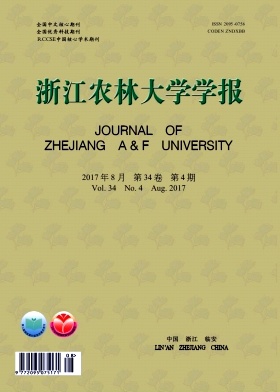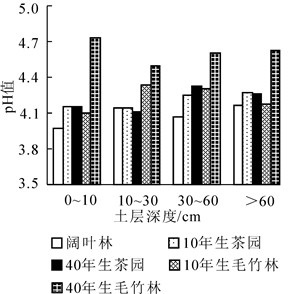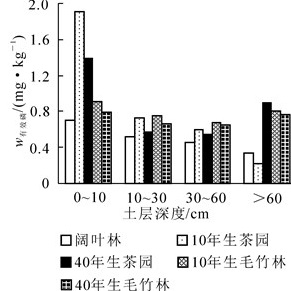-
土壤肥力是土壤质量的主要构成部分,包括土壤肥力各因子的数量、在特定的环境条件下与诸因子协同作用下的养分有效性以及特定植物的养分需求和产出[1]。土壤肥力高低不仅受土壤养分、植物的吸收能力和植物生长的环境条件各因子的单独影响,也取决于各因子的协调程度。土壤肥力质量研究必须同时兼顾农业生产力和环境保护2个方面。浙江省安吉县位于浙江省西北部,土地总面积为1 887 km2,是中国著名的竹子和白茶Camellia sinensis之乡。毛竹Phyllostachys edulis和白茶是安吉县农林业的两大支柱产业。拥有规模生产茶园面积1.13 ×104 hm2,产量1 800 t·a-1,产值20亿元·a-1,占全县农业总产值1/4[2]。安吉县竹林面积居全国前列,浙江首位,竹业总产值居全国之首,其中毛竹林面积为5.53×104 hm2,覆盖率达29.3%,面积占全县森林面积的41.2%[3]。土壤肥力质量的高低与土地利用方式的改变也密切相关。由于栽培毛竹和白茶的经济效益高,尤其白茶利润丰厚,致使安吉县毛竹和白茶的栽培面积逐年扩大[4],其中大部分是由常绿阔叶林改变而来,导致森林资源破坏,水土流失严重[2]。黄锦法等[5]报道了稻麦轮作田改为保护地菜田土壤肥力质量的演变,但常绿阔叶林改为毛竹林和白茶园后土壤肥力质量的演变并未有人涉及。本研究根据安吉县森林资源经营档案,在全面踏查的基础上,在该县梅溪镇钱坑桥村的3个小流域,进行了常绿阔叶林改为毛竹林和白茶园后土壤肥力质量的演变研究,以期为毛竹林、白茶园土壤肥力质量的提高和森林可持续经营提供理论依据。
HTML
-
研究区位于安吉县东端的梅溪镇(30°28′ N, 119°24′ E),处于天目山脉在安吉境内的东支末梢,北亚热带季风气候,年平均气温为15.1 ℃,年降水量为1 286.0 mm,无霜期228.0 d。该区的原生植被为天然阔叶林,绝大部分分布于低山丘陵地带。天然植被有青冈Cyclobalanopsis glauca-苦槠Castanopsis sclerophylla常绿阔叶林、马尾松Pinus massoniana林、针阔混交林、竹林以及灌丛植被。人工植被有杉木Cunninghamia lanceolata林,湿地松Pinus elliottii林及经济林。土壤主要是发育于酸性岩浆岩和沉积岩的红壤土类。梅溪镇是安吉县主要毛竹产区,毛竹林面积为2 700 hm2;白茶栽培面积为1 300 hm2,占安吉县白茶产量的1/5。毛竹林通常每年5月上、中旬施肥1次,肥料用量控制在100~150 kg·hm-2。白茶施肥2次·a-1,修剪后施1次追肥,10月后施1次基肥。肥料以有机肥为主(30~35 t·hm-2),适量使用复合肥(300~450 kg·hm-2)。
-
2015年7月,在梅溪镇钱坑桥村的3个小流域(区组),分别选择有代表性的10年生和40年生毛竹林和白茶园各3块(20 m × 20 m),并在样地周围选择40年生常绿阔叶林作为对照,挖土壤剖面3个·区组-1,分别采集0~10,10~30,30~60和>60 cm等4个土层样品,剔除粗大根系和砾石,同时用容重圈采集土壤。将3个剖面的土样按相同土层深度分别混匀,以四分法取500 g样品带回实验室。采回的土样经自然风干后,去除根系后,用木棍碾碎,过2 mm孔径筛子,供化学分析用。分析方法如下:土壤pH值[m(土):m(水)=1:5]用酸度计测定,有机碳采用重铬酸钾外加热法,碱解氮用碱解扩散法,有效磷采用盐酸-氟化铵(HCl-NH4F)浸提钼锑抗比色法,速效钾用醋酸铵浸提火焰光度法,土壤容重用环刀法测定[6]。
-
试验数据采用利用Excel 2003进行数据统计、相关性分析和作图,用SPSS 18.0系统进行方差分析,并采用Duncan’s新复极差法(LSR)在0.05水平下进行多重比较。
1.1. 研究区概况
1.2. 土壤采样与分析方法
1.3. 数据统计
-
常绿阔叶林改为毛竹林和白茶园并集约经营10 a和40 a后的土壤pH值(图 1)和有机碳质量分数的结果(图 2)显示,不同林地土壤pH值不同土层之间没有显著性差异,但土壤有机碳质量分数则随土层深度的增加而显著下降。不同林地土壤碱解氮、有效磷和速效钾质量分数随土层深度的增加而显著下降(图 3~5)。耕作层(0~30 cm)土壤容重低于心土层(30~60 cm),但差异没有达到5%显著水平(表 1)。
土层/cm 土壤容重/(g·cm-3) 阔叶林 10年生茶园 40年生茶园 10年生毛竹林 40年生毛竹林 0~30 1.34 a 1.05 b 1.09 b 1.14 b 1.11 b 30~60 1.42 a 1.26 b 1.24 b 1.24 b 1.23 b Table 1. Bulk densities in the soils under different utilization ways
-
常绿阔叶林改为白茶园和毛竹林10年生后各个土层的土壤pH值均有不同程度升高,40年生白茶园各个土层的土壤pH值与10年生白茶园各个土层的土壤pH值之间没有显著差异,但40年生毛竹林各个土层的土壤pH值比10年生毛竹林各个土层的土壤pH值提高了0.27~0.63(图 1)。
与常绿阔叶林比较,10年生白茶园的0~10 cm土层有机碳质量分数略有降低,但其他各土层有机碳质量分数有明显增加。随着种植年限的增加,40年生白茶园的0~30 cm土层有机碳质量分数又有了明显的降低,但30 cm以下土层的有机碳质量分数并未降低;10年生毛竹林的0~10 cm土层的有机碳质量分数降低了8.97 g·kg-1,但其他各土层的有机碳质量分数基本没有下降,40年生毛竹林的各土层的有机碳质量分数维持10年生毛竹林土壤有机碳水平(图 2)。
与常绿阔叶林相比,10年生白茶园0~10 cm和10~30 cm土层的碱解氮质量分数略有降低,40年生白茶园碱解氮质量分数进一步降低,分别降低了26.1 mg·kg-1和11.9 mg·kg-1,30 cm以下土层的碱解氮质量分数呈现先增后减的趋势(图 3)。白茶园和毛竹林0~10 cm和10~30 cm土层的有效磷和速效钾质量分数,呈现随栽培年限增加先增后减的趋势。30 cm以下土层有效磷和速效钾质量分数随有效磷和速效钾质量分数增加呈现无规律的变化(图 4~5)。
常绿阔叶林改为白茶园后,10年生白茶园和毛竹林的土壤容重显著降低了,但40年生白茶园和40年生毛竹林的土壤容重就不再降低了。
-
不同林地土壤有机碳质量分数与土壤速效养分质量分数之间的相关分析结果显示:土壤有机碳质量分数与土壤碱解氮质量分数(图 6A),速效钾质量分数(图 6B)之间的相关性均达到极显著水平(P<0.01),而与土壤有效磷质量分数(图 6C)的相关性未达5%显著水平。
-
参照林地土壤和园地土壤肥力的分级指标(表 2)[7-8],安吉县不同种植年限的白茶园和毛竹林土层的有机碳质量分数分别为35.03~42.16 g·kg-1和18.24~35.03 g·kg-1,换算为有机质质量分数分别为60.39~72.68 g· kg-1和31.45~60.39 g·kg-1,属于4级水平;碱解氮质量分数分别为40.4~71.3 mg·kg-1和28.5~42.8 mg·kg-1,属于4级水平;有效磷质量分数分别为0.79~1.91 mg·kg-1和0.57~0.75 mg·kg-1,属于5级水平;速效钾质量分数分别为43.5~82.5 mg·kg-1和22.1~46.5 mg·kg-1,属于4级水平。
Table 2. Fertility grading indicators of the soils under orchards and forest stands
2.1. 不同利用方式下土壤肥力随土层深度的变化
2.2. 不同利用方式下土壤肥力的比较
2.3. 土壤有机碳质量分数与土壤速效养分质量分数之间的相关分析
2.4. 常绿阔叶林改为毛竹林和白茶园后土壤肥力质量的评价
-
随着农林产业结构的逐步调整,浙江省以果、蔬、茶、竹为主的经济作物面积不断扩大,如由杭嘉湖平原稻麦轮作田改为蔬菜等经济作物连作的旱地和半永久性的保护地[5],浙北稻田或林地改为毛竹[9-10]、雷竹Phyllostachys violascens[11-12]和白茶等经济作物。由于改制前后的土壤类型、作物及施肥管理模式的不同,导致改制后土壤肥力质量的演变趋势产生巨大差异。例如,稻麦轮作田改为保护地菜田后,pH值大幅下降,导致土壤酸化[5],稻田改为毛竹和雷竹同样导致了土壤酸化[10-12]。但本研究常绿阔叶林改为毛竹林和白茶园后并未引起土壤酸化,甚至土壤pH值略有升高。究其原因,一是稻田改为雷竹林后的施肥量,特别是化肥用量大大高于本研究的样地,二是稻田土壤pH值高于林地[10]。基于同样的理由,稻田改为雷竹林后土壤有机质、全氮、速效磷、速效钾等均有大幅增加,尤其是速效磷超负荷累积[12-15],但本研究毛竹林和茶园的土壤有机质、速效磷、速效钾增加幅度很小,其土壤肥力指标仍属缺乏范围。
改制后土壤肥力质量随种植时间增加的演变趋势因不同改制模式也有巨大差异。强度集约经营导致雷竹林土壤有机质质量分数和速效氮磷钾质量分数随时间推移而大幅提高[12-15]。姜培坤等[11]报道,2007年土壤有机质质量分数比1999年增加了1.00倍,平均增加3.34 g·kg-1·a-1,土壤全氮和速效氮质量分数分别增长2.47倍和2.05倍,土壤速效磷质量分数增长10.10倍,土壤速效钾提高44.0%。本研究的种植10年生和40年生的毛竹林和白茶园0~10 cm土壤的有机碳质量分数反而略有降低,土壤碱解氮、速效磷、速效钾的增加幅度也很小。与改制后强度集约经营雷竹林土壤有机质质量分数和速效氮磷钾质量分数随时间变化趋势相反,集约经营导致毛竹林土壤有机质质量分数在前20 a随时间推移而快速下降,此后趋向平衡[10, 16-17],其原因是雷竹集约经营的强度比毛竹高,而且雷竹经营过程中还采取了覆盖措施。另外相关研究表明,适量的施肥有利于土壤有机质的积累[18],一般经营毛竹林土壤有机质含量大于集约经营[19]。本研究的结果显示:常绿阔叶林改为毛竹林和白茶园后土壤肥力质量的演变趋势是土壤pH值略有升高,土壤有机碳、碱解氮和速效钾质量分数属于缺乏水平,而速效磷质量分数属于极度缺乏水平,因此,从土壤肥力质量演变趋势看来,应适当增加有机肥和化肥的用量,以确保土壤肥力质量的提高。






 本站查看
本站查看







 DownLoad:
DownLoad: